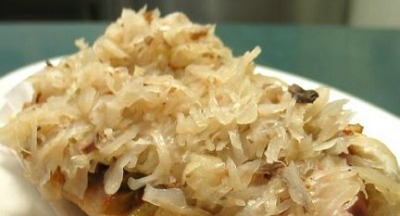Sauerkraut (also known as sourcrout) is a finely-chopped cabbage that is salted and then fermented in its own juice. Homemade sauerkraut is a world apart from the stuff that comes from the grocery store.
The word, which in German means “sour cabbage,” is first mentioned in American English in 1776 and the dish was long associated with German communities in the United States.
Sauerkraut was also a Pennsylvania Dutch specialty. The immigrants to America carried barrels of sauerkraut with them on their ship, as the properties in sauerkraut helped fight disease. Pennsylvania Dutch cooking is indigenous to those areas of southeastern Pennsylvania that were settled by the Mennonites and Amish.
Sauerkraut is made by placing salt between layers of finely-shredded or chopped cabbage and then subjecting it to pressure, which bruises the cabbage and squeezes out its juices. It then ferments
Sauerkraut History (SOW-uhr-krowt)
The word, which in German means “sour cabbage,” is first mentioned in American English in 1776 and the dish was long associated with German communities in the United States.
Sauerkraut was also a Pennsylvania Dutch specialty. The immigrants to America carried barrels of it with them on their ship, as the properties in sauerkraut helped fight disease. Pennsylvania Dutch cooking is indigenous to those areas of southeastern Pennsylvania that were settled by the Mennonites and Amish.
William Penn (1644-1718), founder of Pennsylvania, was seeking colonists for the Pennsylvania area. The Amish and Mennonites both settled in Pennsylvania as part of William Penn’s “holy experiment” of religious tolerance. He wanted to establish a society that was godly, virtuous and exemplary for all of humanity. Encouraged by William Penn’s open invitation to persecuted religious groups, various sects of Christian Anabaptists-Mennonites and offshoots such as the Amish and the Brethren-emigrated from Germany and Switzerland. The first sizeable group arrived in America around 1730 and settled near Lancaster County, Pennsylvania.
Chinese cooks were also pickling cabbage in wine (as easy as 200 B.C.) and using it as a accompaniment to meals. Genghis Khan substituted salt for the wine and carried this “sauerkraut” (as it is now called) to the eastern edge of Europe.
As to who discovered sauerkraut – I don’t know. Your guess is as good as mine.
Tips:
When using canned sauerkraut, to reduce its brine flavor, place into a colander and rise well under cold, running water. Drain well before using.
Store canned sauerkraut in a cool, dark place.
Refrigerate fresh sauerkraut and use within one week.
Sauerkraut is also delicious cooked with one or two tart apples, which have been peeled, cored, and chopped into small pieces. Cook only until it is thoroughly heated; the apples should remain crisp.

